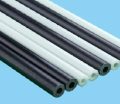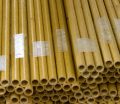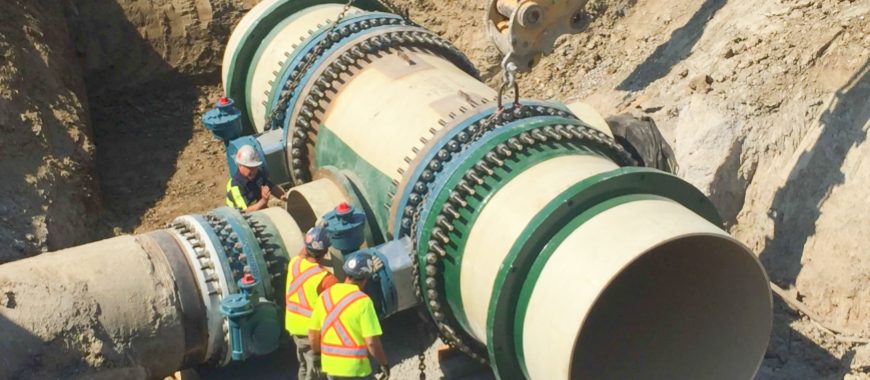
High pressure fiberglass pipe (1½-36 in.) handles 150-4,000 psi, ideal for corrosion-resistant high-volume fluid transfer. Fast assembly. High pressure fiberglass pipe is a specialized type of pipe designed to handle demanding conditions, particularly in high-pressure environments. These pipes are widely used in the oil and gas industry due to their corrosion resistance, durability, and ability to withstand harsh chemicals and extreme temperatures. Compared to traditional steel or metal pipes, high pressure fiberglass pipe offers the benefit of being lighter, which reduces transportation and installation costs. Additionally, its long lifespan and low maintenance requirements make it a cost-effective solution for industrial applications. High pressure fiberglass pipe is favored for use in pipelines, chemical processing plants, and offshore facilities, where durability and efficiency are crucial.
High Pressure Fiberglass Pipe: A Comprehensive Look
What is High Pressure Fiberglass Pipe
High pressure fiberglass pipe is a crucial component in industries that demand durable, corrosion-resistant, and lightweight materials, particularly in oil and gas applications. This type of fiberglass pipe is designed to handle extreme pressures and harsh environments while maintaining long-lasting performance. Its unique material composition and production process make it a preferred choice over traditional metal pipes, especially in areas where cost-efficiency, durability, and ease of installation are important.
The Key of High Pressure Fiberglass Pipe
High pressure fiberglass pipe has become a dominant material for pipelines due to its numerous advantages over steel or other metal alternatives. The combination of glass fibers and high-performance resin allows these pipes to exhibit superior strength, thermal resistance, and corrosion resistance. One of the primary benefits is its ability to endure high pressures while remaining lightweight, which reduces the need for heavy equipment during transportation and installation.
For industries like oil and gas, where infrastructure often faces corrosive substances and extreme temperatures, high pressure fiberglass pipe offers a highly reliable solution. GangLong Fiberglass products have been specifically designed to meet the growing demand for pipes that can withstand such conditions while maintaining high performance levels over long periods. The use of fiberglass material also significantly reduces maintenance costs, as these pipes do not rust, and their structural integrity remains intact even in challenging environments.
Material Composition and Manufacturing Process
The production of high pressure fiberglass pipe begins with a carefully engineered blend of materials. Typically, the pipe consists of continuous glass fibers wound around a steel mandrel and coated with an epoxy resin system. This manufacturing process, which involves the creation of Fiberglass Filament Wound Tubes, is known as filament winding, and it is key to achieving the high strength-to-weight ratio that makes fiberglass pipes so attractive in various industries.
The filament winding method involves rotating the mandrel as fibers are precisely wound onto it in multiple layers. Each layer of glass fiber is saturated with epoxy resin, which helps to form a strong bond between the fibers, resulting in a composite material with superior mechanical properties. This process allows manufacturers like GangLong Fiberglass to create pipes that are capable of withstanding pressures that exceed those handled by traditional steel pipes.
Additionally, the resin used in high pressure fiberglass pipe is often formulated with specific chemical resistances to meet the needs of the application. For instance, Bisphenol-A based epoxy resin is commonly used for its excellent thermal and chemical resistance, which makes it ideal for applications in environments exposed to corrosive chemicals or extreme heat.
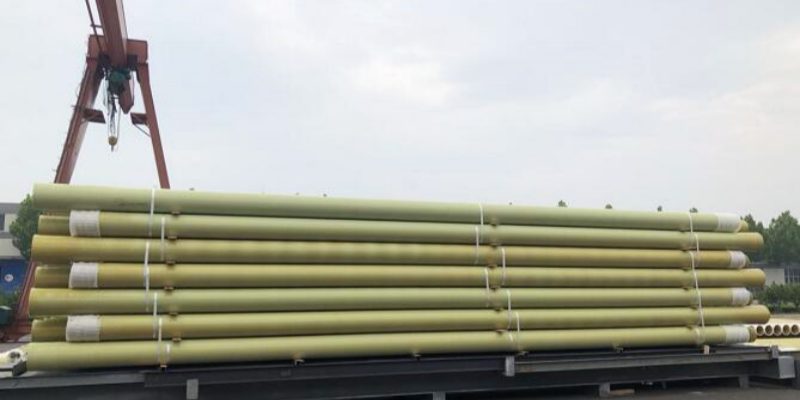
Top Affecting Rigid Fiberglass Tubing Price
Key Features of High Pressure Fiberglass Pipe
High pressure fiberglass pipes, including large diameter fiberglass pipe, are becoming increasingly popular in industries requiring durable and reliable piping solutions. These pipes offer several key features that make them ideal for demanding applications, providing a variety of benefits that contribute to their effectiveness and longevity in various environments.
High-Pressure Capability
High pressure fiberglass pipe is specifically engineered to withstand extreme pressure levels, making it ideal for transporting fluids under challenging conditions. Its construction ensures it can safely handle high-pressure applications in industries like oil and gas, chemical processing, and power generation. This capability allows it to function efficiently even in critical environments where traditional materials might fail under stress or pressure.
Corrosion Resistance
One of the standout features of high pressure fiberglass pipe is its exceptional corrosion resistance. Made from fiberglass reinforced polymer (FRP), these pipes are designed to resist degradation caused by exposure to moisture, chemicals, and environmental factors. This property is particularly valuable in industries that deal with corrosive substances or operate in harsh environments. The fiberglass material ensures that the pipe maintains its integrity over time, significantly reducing the need for frequent maintenance and replacements.
Lightweight and High Strength
High pressure fiberglass pipe combines the strength of traditional materials with a lightweight design. The use of advanced composite materials ensures that the pipe is strong enough to withstand high pressure and mechanical stress while remaining significantly lighter than metal alternatives. This makes handling and installation easier and less costly, reducing labor and equipment needs during installation. Despite its lighter weight, high pressure fiberglass pipe maintains excellent structural integrity, ensuring long-term performance and reliability.
Enhanced Safety
Safety is a top priority in high-pressure applications, and high pressure fiberglass pipe is designed with safety features that help mitigate risks. Unlike metal pipes, the non-metallic construction of fiberglass eliminates the risk of sparks, which can be a concern in hazardous environments like chemical plants, oil rigs, and gas processing facilities. This spark-proof quality makes high pressure fiberglass pipe a safer option in areas where explosive gases or flammable liquids are present, thus reducing the risk of accidents and enhancing worker safety.
Thermal Stability
High pressure fiberglass pipe is built to withstand a wide range of temperatures, making it reliable in both high and low-temperature environments. Whether in extreme heat or cold, these pipes maintain their performance and structural integrity. Their thermal stability ensures that they can transport fluids under consistent pressure and temperature conditions without degrading or losing effectiveness. This makes them particularly well-suited for use in industries like power generation, where temperature fluctuations are common.
Chemical Resistance
High pressure fiberglass pipe, made from fiberglass reinforced polymer (FRP), provides excellent resistance to a wide variety of chemicals, including acids, alkalis, solvents, and other corrosive substances. This chemical resistance is vital for industries such as chemical processing, petrochemicals, and wastewater treatment, where pipes must carry fluids that could otherwise corrode traditional materials. The ability of high pressure fiberglass pipe to resist chemical attacks ensures that they perform reliably over extended periods, even when transporting highly corrosive materials.
Longevity and Cost Efficiency
One of the key advantages of high pressure fiberglass pipe is its longevity and cost-effectiveness over time. The inherent durability of the fiberglass material ensures that these pipes have a long service life, requiring less maintenance and reducing the frequency of repairs or replacements. This translates into significant cost savings for businesses in the long term, as they avoid the high expenses associated with maintaining or replacing traditional metal piping systems. The low maintenance requirements and extended lifespan of high pressure fiberglass pipe make them a cost-efficient investment for industries seeking reliable, long-lasting piping solutions.
Advantages of High Pressure Fiberglass Pipe Over Traditional Materials
High pressure fiberglass pipes offer numerous advantages over traditional materials such as steel and concrete, including the flexibility of fiberglass, which allows for easier installation and better adaptability in complex piping systems. The flexible fiberglass construction not only enhances installation efficiency but also ensures durability and corrosion resistance, making them increasingly popular in industries that require reliable and long-lasting piping solutions.
| Advantage | High Pressure Fiberglass Pipe | Traditional Materials |
|---|---|---|
| Corrosion Resistance | Highly resistant to corrosion, ideal for harsh environments. | Prone to rust and corrosion, requiring frequent repairs. |
| Lightweight and Easy Installation | Lighter, easier to transport and install in hard-to-reach areas. | Heavier, requiring more equipment and labor. |
| Long Lifespan and Low Maintenance | Durable with minimal upkeep needed. | Requires frequent maintenance and replacement. |
| Customization and Versatility | Available in various sizes and pressure ratings, with flexible connections. | Limited in customization and connection options. |
| Durability and Impact Resistance | Strong and impact-resistant, less prone to damage. | Vulnerable to cracking and damage under pressure. |
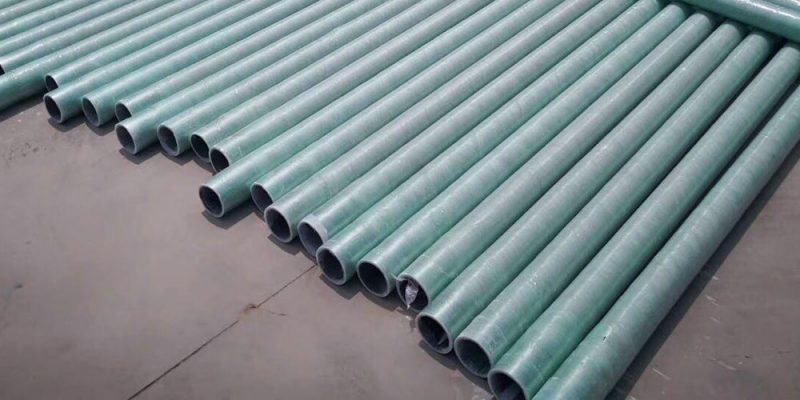
Applications of High Pressure Fiberglass Pipe
High pressure fiberglass pipes, including transparent fiber pipe, are widely utilized across various industries due to their versatility, durability, and resistance to harsh conditions. Below is an expanded overview of the most common applications of high pressure fiberglass pipes:
Oil and Gas Industry
High pressure fiberglass pipes are used extensively in offshore drilling and production platforms. Their resistance to corrosion, ability to withstand high pressure, and lightweight nature make them ideal for subsea pipelines. These pipes reduce installation costs and simplify logistics, ensuring efficient transportation and performance in harsh offshore conditions.
Chemical Processing
Chemical plants use high pressure fiberglass pipes for transporting aggressive chemicals. Fiberglass pipes offer resistance to a broad range of chemicals, acids, and high temperatures, ensuring long-term infrastructure reliability. These pipes reduce maintenance costs and downtime, making them perfect for environments where metal pipes would degrade quickly due to corrosion or chemical exposure.
Water Treatment and Power Generation
High pressure fiberglass pipes are essential in water treatment plants and power generation facilities. Their corrosion resistance is crucial in these environments, where pipes are exposed to moisture and varying temperatures. These pipes are also lightweight and easy to install, providing cost-effective solutions while ensuring reliable fluid transportation across these critical infrastructure systems.
Mining and Minerals
In mining, high pressure fiberglass pipes are used for slurry transport and mine dewatering. Their strength, corrosion resistance, and durability make them ideal for handling harsh mining conditions. These pipes help transport fluids efficiently while minimizing maintenance costs, ensuring smooth operations in demanding environments like mining sites and mineral processing plants.
Desalination
In desalination plants, high pressure fiberglass pipes are used to transport seawater, chemicals, and fresh water. Their resistance to seawater corrosion ensures long-lasting performance in coastal environments. These pipes contribute to the efficiency and reliability of desalination processes, providing a durable and effective solution for converting seawater into fresh water.
Cooling Systems and Gravity Sewers
Fiberglass pipes are widely used in cooling systems and gravity sewer applications. Their resistance to corrosion makes them ideal for transporting cooling water in power plants and industrial facilities. Similarly, their durability and flexibility ensure reliable wastewater management in gravity sewer systems, making them an excellent choice for critical infrastructure.
How to Choose the Right Tapered Fiberglass Tube Size
Trends in High Pressure Fiberglass Pipe Manufacturing
The high pressure fiberglass pipe market is experiencing growth as industries shift towards fiberglass for its benefits over traditional materials. Several key trends are shaping the future of this industry, including sustainability, advancements in resin technology, and expansion in emerging markets.
Sustainability and Eco-Friendly Materials
As industries focus on sustainability, the demand for eco-friendly materials in high pressure fiberglass pipe manufacturing is increasing. GangLong Fiberglass leads this trend, developing new resin systems that offer high performance while reducing environmental impact. These resins provide the same strength and durability as traditional materials but with lower emissions and a smaller environmental footprint, aligning with global green initiatives.
Advancements in Resin Technology
Recent advancements in resin technology have significantly improved fiberglass pipes’ resistance to chemicals, heat, and pressure. These innovations allow fiberglass pipes to handle a wider range of applications, including offshore drilling and chemical processing. GangLong Fiberglass has leveraged these advancements, producing resin systems that ensure even greater durability and versatility, making fiberglass pipes an ideal choice for demanding industries like oil and gas, chemical processing, and wastewater treatment.
Growth in Emerging Markets
Emerging markets are driving the demand for high pressure fiberglass pipes, as these regions expand their infrastructure. Fiberglass pipes offer an attractive alternative to traditional materials, providing cost-effective and reliable solutions. GangLong Fiberglass is strategically positioned to serve these markets, supplying high-quality products that meet the needs of rapidly developing economies. With growing infrastructure projects in industries like oil, gas, and water treatment, fiberglass pipes offer an ideal combination of performance and sustainability.
Technological Integration and Automation
Manufacturers are increasingly integrating automation and advanced technologies into fiberglass pipe production. Automated systems improve efficiency, precision, and consistency while lowering production costs. Digital tools like 3D modeling and simulation are also used for optimizing pipe design. GangLong Fiberglass incorporates these technologies to produce high-quality pipes faster, meet rising demand, and ensure that pipes are tailored to the specific needs of industries, enhancing both performance and reliability in the manufacturing process.
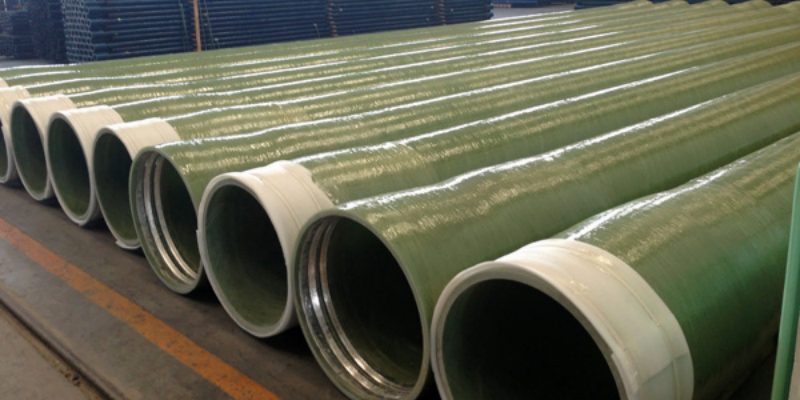
Why choose GangLong Fiberglass for your project
High-Pressure Capability and Industry-Specific Solutions
In industries like oil and gas, the demand for high pressure fiberglass pipes with specific technical qualities is paramount. We use a competent discontinuous filament winding system (CFW) to produce high-pressure fiberglass pipes that meet the extreme environmental requirements of oil sites. These pipes are designed to withstand the challenging conditions of the oil and gas sector, offering exceptional durability and reliability even in harsh environments.
Customized Resin Selection for Optimal Performance
When selecting materials for fiberglass pipes, the choice of resin is crucial for achieving the desired performance. At GangLong Fiberglass, we provide a range of resins used in the filament winding process, including polyester, vinyl ester, and epoxy resins. Each resin offers varying levels of corrosion resistance, thermal stability, and pricing, allowing you to select the optimal option based on the specific requirements of your project.
Tailored Glass Fiber Selection
In addition to resin choice, the type of glass used in the production process significantly influences the final product’s strength and performance. At GangLong Fiberglass, we work with a range of glass types to meet the specific needs of each project, ensuring the highest standards in both durability and mechanical strength. This flexibility in material selection allows us to produce fiberglass pipes and fittings that are perfectly suited to the unique demands of our clients’ industries.
Commitment to Quality and Reliability
At GangLong Fiberglass, we are committed to providing the best solutions for every project. Whether you require high-pressure fiberglass pipes for offshore oil drilling, industrial piping systems for water transfer, or large-scale infrastructure projects, our fiberglass products are designed to perform under the most demanding conditions. With our high-quality materials, industry-compliant production processes, and commitment to customer satisfaction, GangLong Fiberglass is the trusted partner for your next project.
Top Benefits of Using Silicone Fiberglass Tube in Equipment
FAQs about High Pressure Fiberglass Pipe
Metal pipes, particularly those made from stainless steel, carbon steel, or alloy steel, are known to hold the most pressure, often exceeding 1,000 PSI. These pipes are ideal for heavy-duty applications, such as in oil and gas, high-pressure steam, or industrial machinery. However, FRP (fiberglass reinforced plastic) pipes, while generally designed for moderate pressure applications, are also a strong contender for environments that require corrosion resistance in addition to pressure management. Fiberglass pipes, especially those custom-built with thicker walls and advanced resins, can handle pressures up to 300 PSI or more, making them suitable for various industrial applications where high-pressure ratings are necessary.
The maximum pressure rating for an FRP (Fiberglass Reinforced Plastic) pipe depends on several factors, including the wall thickness, resin type, and specific construction methods used. In most cases, FRP pipes can withstand pressures up to 300 PSI, but certain high-strength designs can exceed this limit. Additionally, environmental factors like temperature and the type of fluid being transported can influence the maximum pressure. For instance, at higher temperatures, the pressure rating typically decreases because of material expansion. Custom-manufactured FRP pipes can be designed to handle higher pressures for specialized applications, offering flexibility across various industries such as petrochemical, marine, and water treatment.
When it comes to high-pressure applications, carbon steel and stainless steel pipes are traditionally considered the best due to their high tensile strength and durability. However, modern advancements in composite materials, such as fiberglass-reinforced plastic (FRP), have made fiberglass pipes a strong competitor. While metal pipes can handle extreme pressures, fiberglass pipes have the advantage of corrosion resistance, making them ideal for use in harsh chemical environments where both high pressure and corrosion are concerns. Additionally, fiberglass pipes are lightweight and easier to install, providing significant cost savings in long-term maintenance. The choice depends on the specific needs of the application, including the fluid type, temperature, and pressure requirements.

As the editor of GangLong Fiberglass, I have years of experience and in-depth research, focusing on cable tray products, fiberglass solutions, and grille systems. I incorporate years of industry insights and practical experience into every content, committed to promoting the progress of the industry. At GangLong Fiberglass, my commitment is reflected in every product, from innovative cable trays to durable fiberglass solutions and sturdy grille systems. As an authoritative voice in the industry, my goal is to provide valuable information to professionals and businesses and promote forward-looking solutions.

